Abstract
The relationship of specific bacteriophages to the production of the lethal alpha toxin in Clostridium novyi types A and B was investigated. When type A strain 5771 reverted to the phage-sensitive state, it ceased to produce alpha toxin but continued to produce the gamma and epsilon antigens. This "nontoxigenic" culture, therefore, more closely resembled C. botulinum types C and D than the other C. novyi types. Phage-sensitive type B strains also ceased to produce the alpha toxin but continued to produce the beta toxin, and therefore very colesly resembled C. novyi type D (C. haemolyticum). Alpha toxin was again produced when the phage-sensitive cultures were reinfected with the respective tox+ phages. Alpha toxin production could also be induced in the "nontoxigenic" phage-sensitive derivatives from type B strain 8024 by tox+ phages isolated from other strains of type B. tox- phages were also isolated, but they did not affect alpha toxin production. The tox+ phages also caused a marked change in the colonial morphology of type B strains. In this report we present evidence that alpha toxin production by C. novyi type A strain 5771 and type B strain 8024 depends upon the continued presence and participation of specific bacteriophages designated as NA1tox+ and NB1tox+, respectively.
Full text
PDF
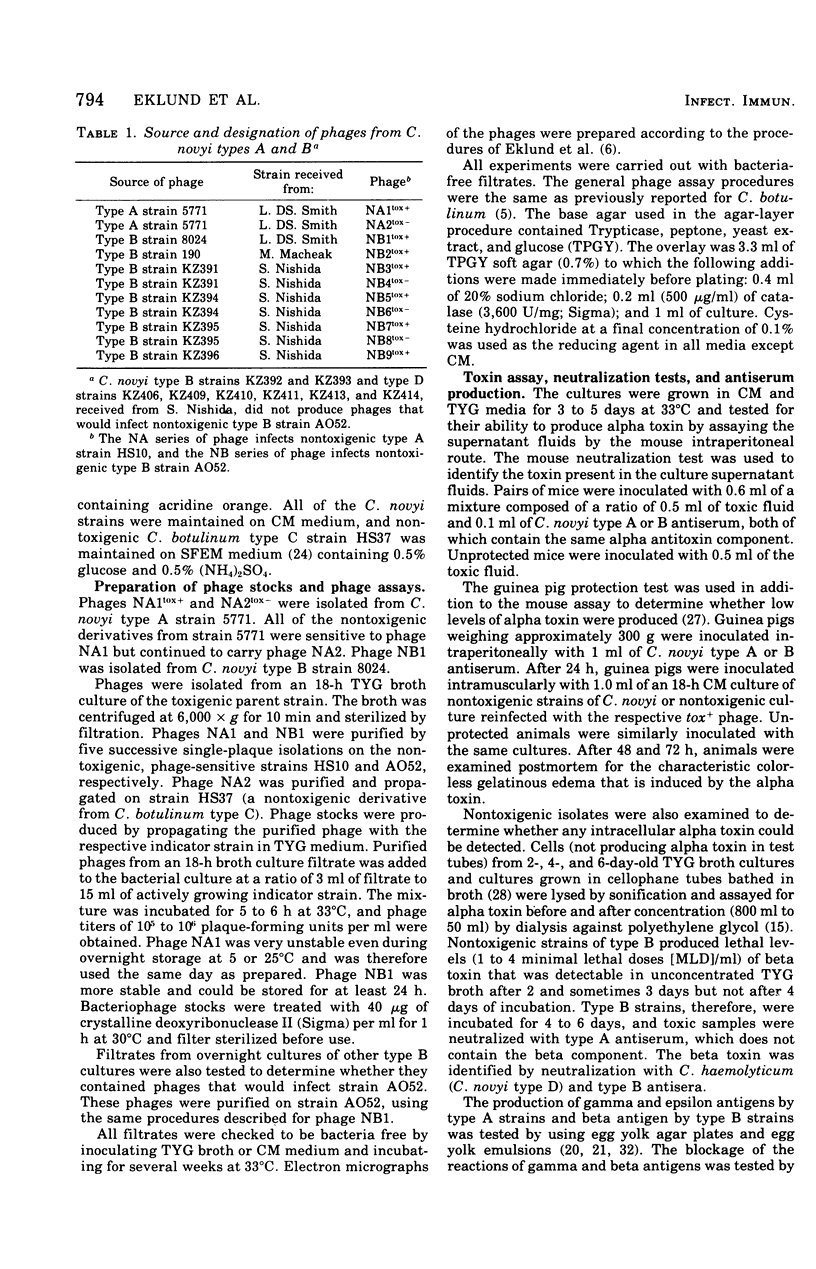




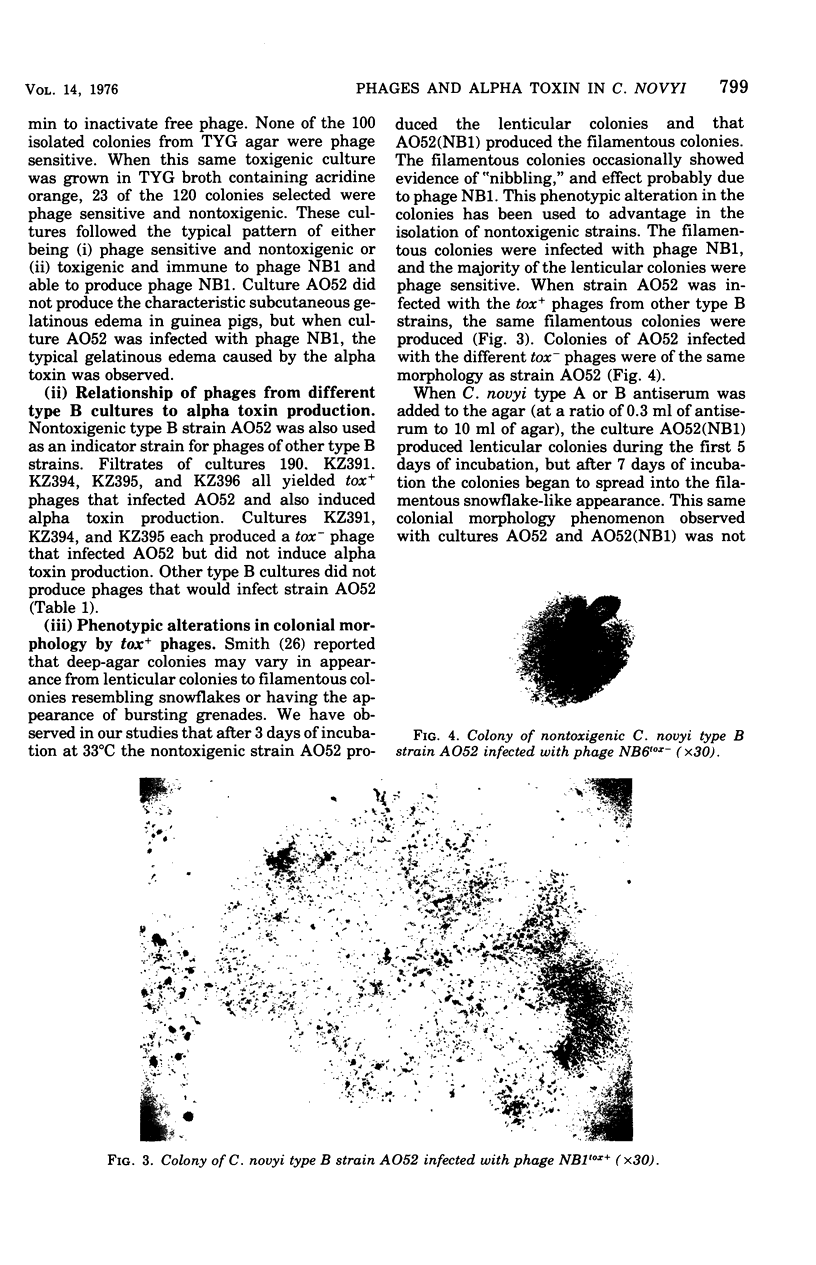
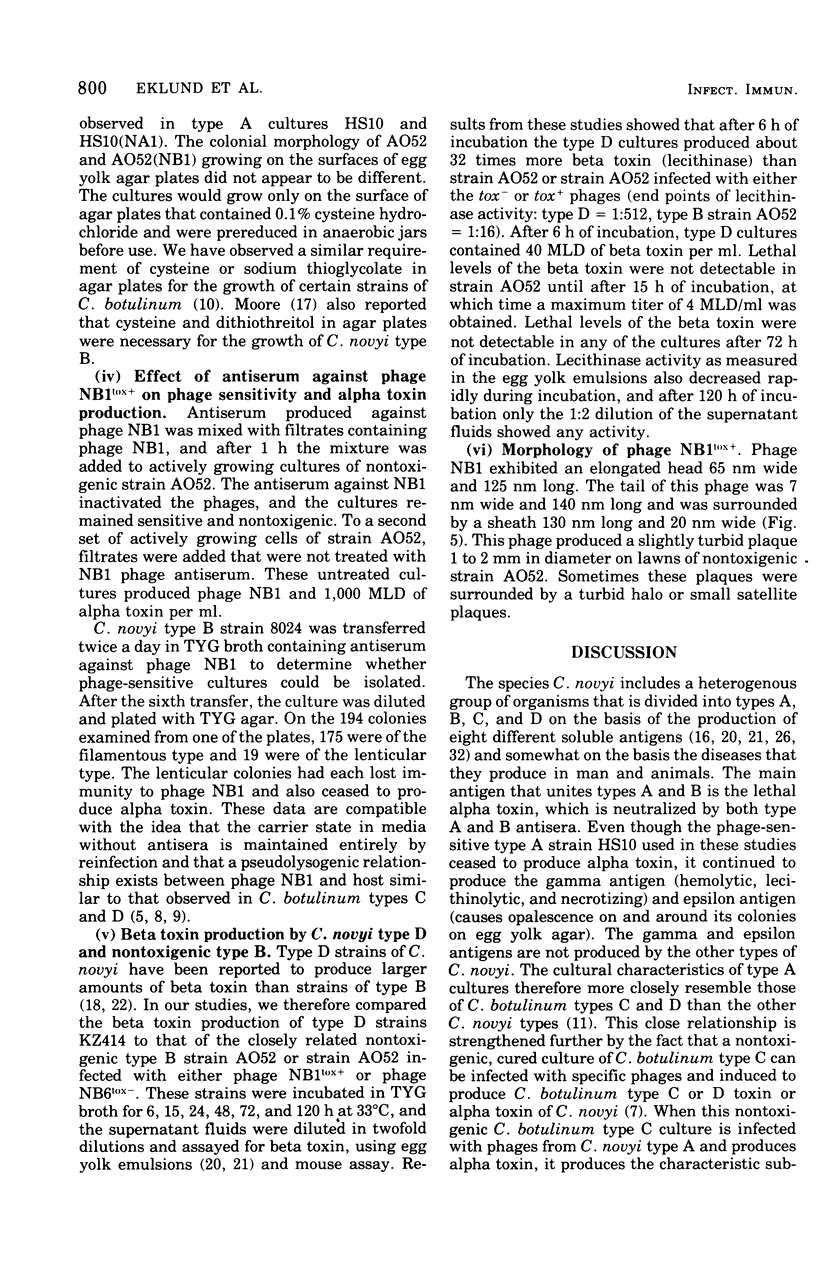
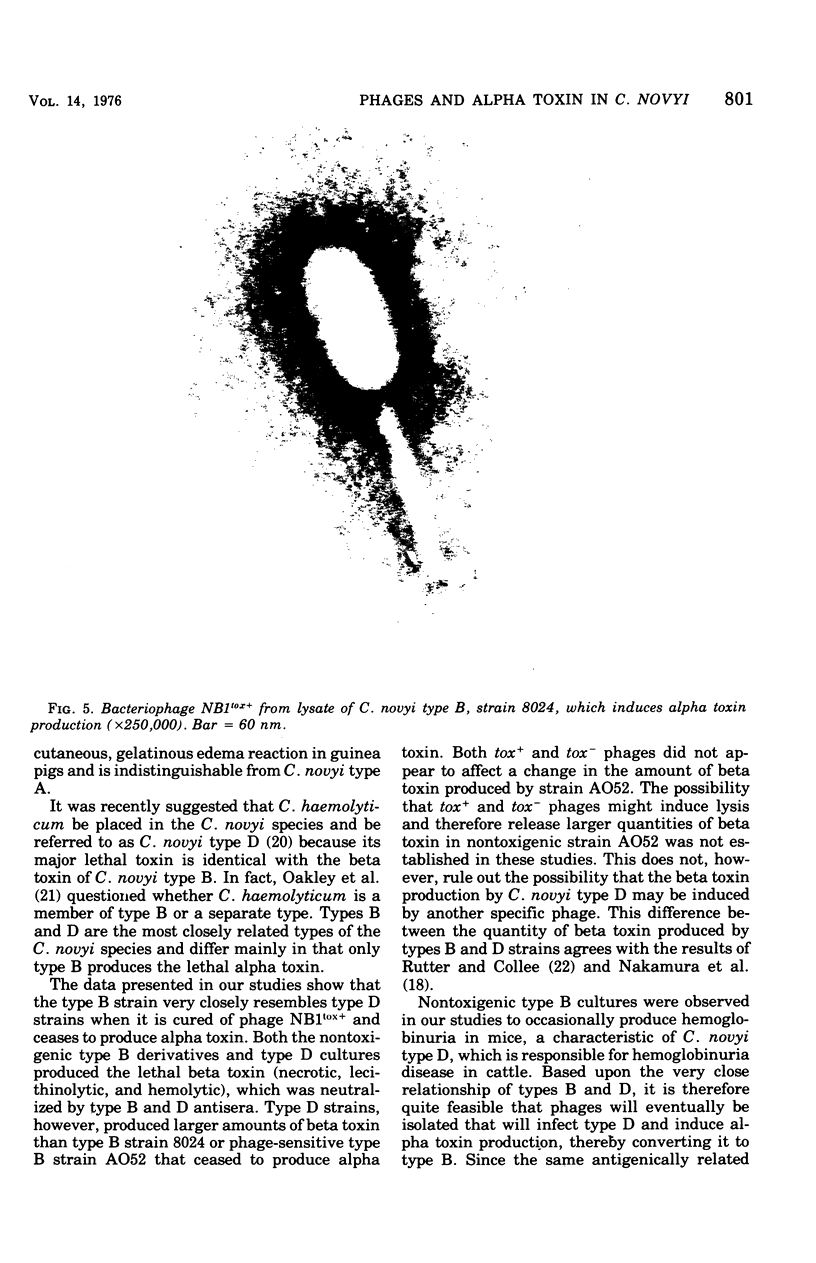
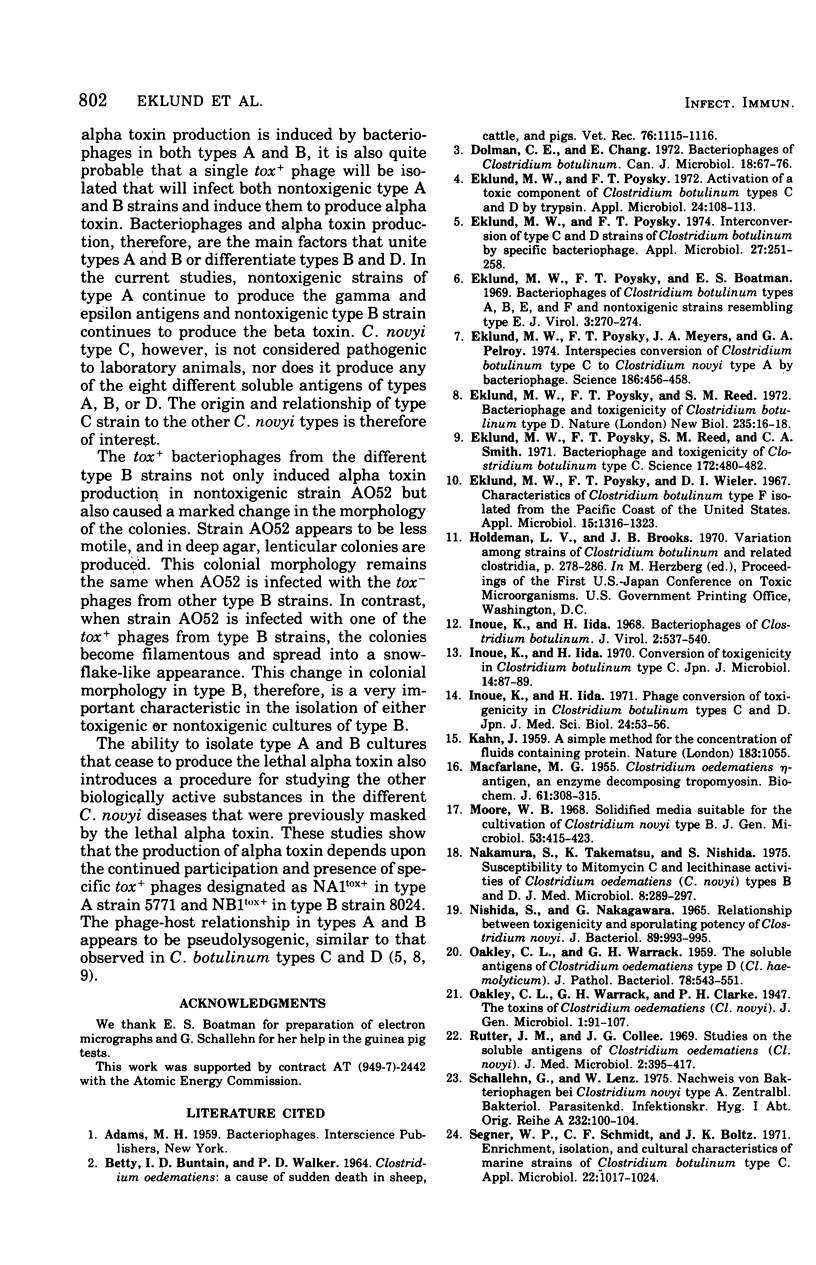
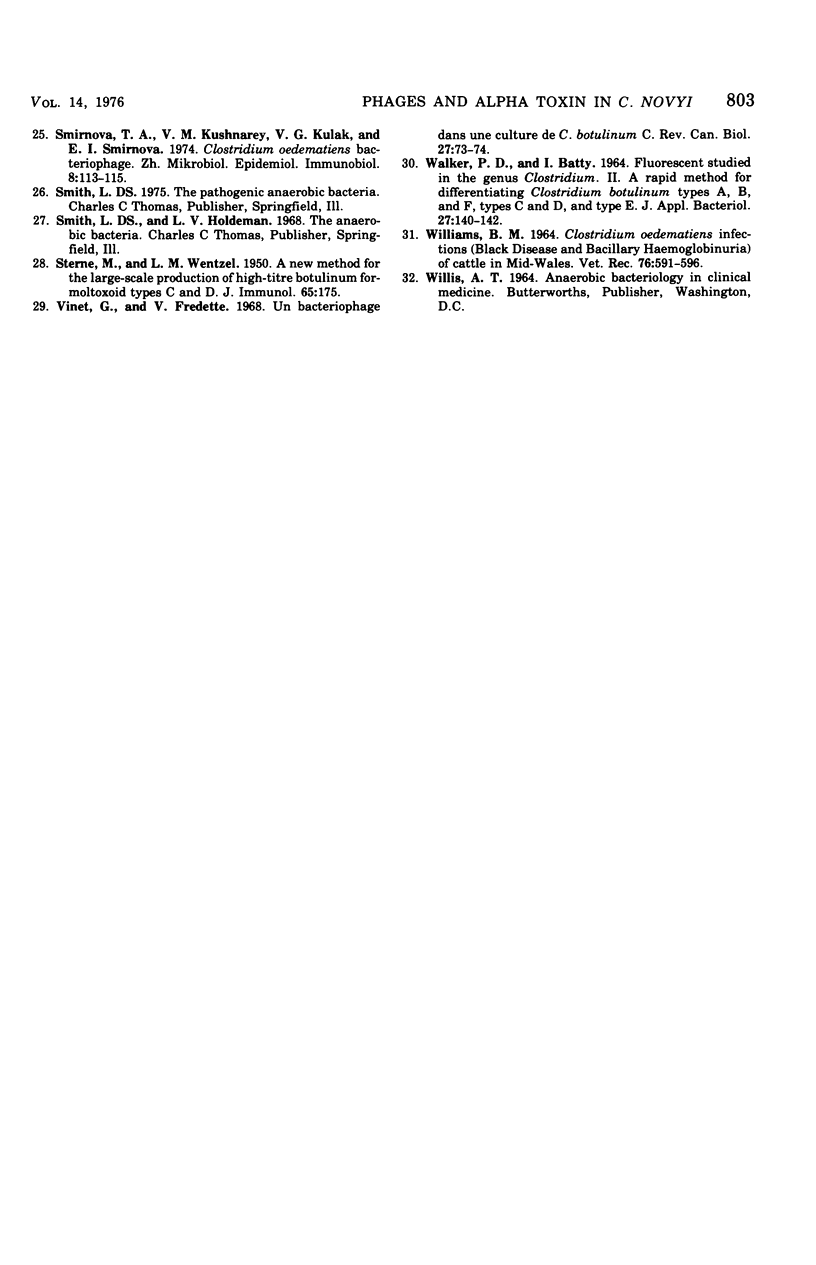
Images in this article
Selected References
These references are in PubMed. This may not be the complete list of references from this article.
- Dolman C. E., Chang E. Bacteriophages of Clostridium botulinum. Can J Microbiol. 1972 Jan;18(1):67–76. doi: 10.1139/m72-011. [DOI] [PubMed] [Google Scholar]
- Eklund M. W., Poysky F. T. Activation of a toxic component of Clostridium botulinum types C and D by trypsin. Appl Microbiol. 1972 Jul;24(1):108–113. doi: 10.1128/am.24.1.108-113.1972. [DOI] [PMC free article] [PubMed] [Google Scholar]
- Eklund M. W., Poysky F. T., Boatman E. S. Bacteriophages of Clostridium botulinum types A, B, E, and F and nontoxigenic strains resembling type E. J Virol. 1969 Feb;3(2):270–274. doi: 10.1128/jvi.3.2.270-274.1969. [DOI] [PMC free article] [PubMed] [Google Scholar]
- Eklund M. W., Poysky F. T. Interconversion of type C and D strains of Clostridium botulinum by specific bacteriophages. Appl Microbiol. 1974 Jan;27(1):251–258. doi: 10.1128/am.27.1.251-258.1974. [DOI] [PMC free article] [PubMed] [Google Scholar]
- Eklund M. W., Poysky F. T., Meyers J. A., Pelroy G. A. Interspecies conversion of Clostridium botulinum type C to Clostridium novyi type A by bacteriophage. Science. 1974 Nov 1;186(4162):456–458. doi: 10.1126/science.186.4162.456. [DOI] [PubMed] [Google Scholar]
- Eklund M. W., Poysky F. T., Reed S. M. Bacteriophage and the toxigenicity of Clostridium botulinum type D. Nat New Biol. 1972 Jan 5;235(53):16–17. doi: 10.1038/newbio235016a0. [DOI] [PubMed] [Google Scholar]
- Eklund M. W., Poysky F. T., Reed S. M., Smith C. A. Bacteriophage and the toxigenicity of Clostridium botulinum type C. Science. 1971 Apr 30;172(3982):480–482. doi: 10.1126/science.172.3982.480. [DOI] [PubMed] [Google Scholar]
- Eklund M. W., Poysky F. T., Wieler D. I. Characteristics of Clostridium botulinum type F isolated from the Pacific Coast of the United States. Appl Microbiol. 1967 Nov;15(6):1316–1323. doi: 10.1128/am.15.6.1316-1323.1967. [DOI] [PMC free article] [PubMed] [Google Scholar]
- Inoue K., Iida H. Bacteriophages of Clostridium botulinum. J Virol. 1968 May;2(5):537–540. doi: 10.1128/jvi.2.5.537-540.1968. [DOI] [PMC free article] [PubMed] [Google Scholar]
- Inoue K., Iida H. Conversion of toxigenicity in Clostridium botulinum type C. Jpn J Microbiol. 1970 Jan;14(1):87–89. doi: 10.1111/j.1348-0421.1970.tb00495.x. [DOI] [PubMed] [Google Scholar]
- Inoue K., Iida H. Phage-conversion of toxigenicity in Clostridium botulinum types C and D. Jpn J Med Sci Biol. 1971 Feb;24(1):53–56. [PubMed] [Google Scholar]
- KOHN J. A simple method for the concentration of fluids containing protein. Nature. 1959 Apr 11;183(4667):1055–1055. doi: 10.1038/1831055a0. [DOI] [PubMed] [Google Scholar]
- MACFARLANE M. G. Clostridium oedematiens n-antigen, an enzyme decomposing tropomyosin. Biochem J. 1955 Oct;61(2):308–315. doi: 10.1042/bj0610308. [DOI] [PMC free article] [PubMed] [Google Scholar]
- Moore W. B. Solidified media suitable for the cultivation of Clostridium novyi type B. J Gen Microbiol. 1968 Oct;53(3):415–423. doi: 10.1099/00221287-53-3-415. [DOI] [PubMed] [Google Scholar]
- NISHIDA S., NAKAGAWARA G. RELATIONSHIP BETWEEN TOXIGENICITY AND SPORULATING POTENCY OF CLOSTRIDIUM NOVYI. J Bacteriol. 1965 Apr;89:993–995. doi: 10.1128/jb.89.4.993-995.1965. [DOI] [PMC free article] [PubMed] [Google Scholar]
- Nakamura S., Takematsu K., Nishida S. Susceptibility to mitomycin C and lecithinase activities of Clostridium oedematiens (C. novyi) type B and D. J Med Microbiol. 1975 May;8(2):289–297. doi: 10.1099/00222615-8-2-289. [DOI] [PubMed] [Google Scholar]
- OAKLEY C. L., WARRACK G. H. The soluble antigens of Clostridium oedematiens type D (CI. haemolyticum). J Pathol Bacteriol. 1959 Oct;78:543–551. doi: 10.1002/path.1700780221. [DOI] [PubMed] [Google Scholar]
- Rutter J. M., Collee J. G. Studies on the soluble antigens of Clostridium oedematiens (Cl. novyi). J Med Microbiol. 1969 Nov 4;2(4):395–417. doi: 10.1099/00222615-2-4-395. [DOI] [PubMed] [Google Scholar]
- STERNE M., WENTZEL L. M. A new method for the large-scale production of high-titre botulinum formol-toxoid types C and D. J Immunol. 1950 Aug;65(2):175–183. [PubMed] [Google Scholar]
- Schallehn G., Lenz W. Nachweis von Bakteriophagen bei Clostridium novyi Typ A. Zentralbl Bakteriol Orig A. 1975 Jun;232(1):100–104. [PubMed] [Google Scholar]
- Segner W. P., Schmidt C. F., Boltz J. K. Enrichment, isolation, and cultural characteristics of marine strains of Clostridium botulinum type C. Appl Microbiol. 1971 Dec;22(6):1017–1024. doi: 10.1128/am.22.6.1017-1024.1971. [DOI] [PMC free article] [PubMed] [Google Scholar]
- Smirnova T. A., Kushnarev V. M., Kulak V. G., Smirnova E. I. Bakteriofag C1. oedematiens. Zh Mikrobiol Epidemiol Immunobiol. 1974 Aug;(8):113–115. [PubMed] [Google Scholar]
- Vinet G., Berthiaume L., Fredette V. Un bactériophage dans une culture de Cl. botulinum C. Rev Can Biol. 1968 Mar;27(1):73–74. [PubMed] [Google Scholar]







